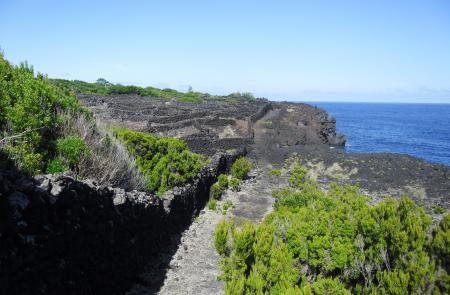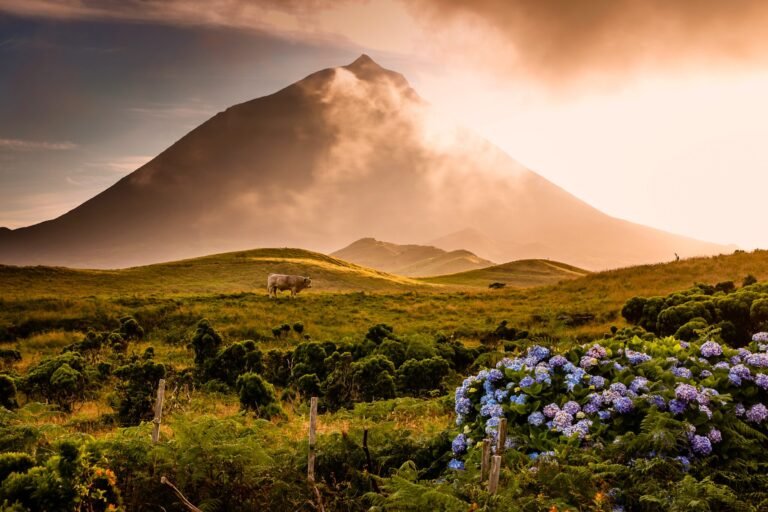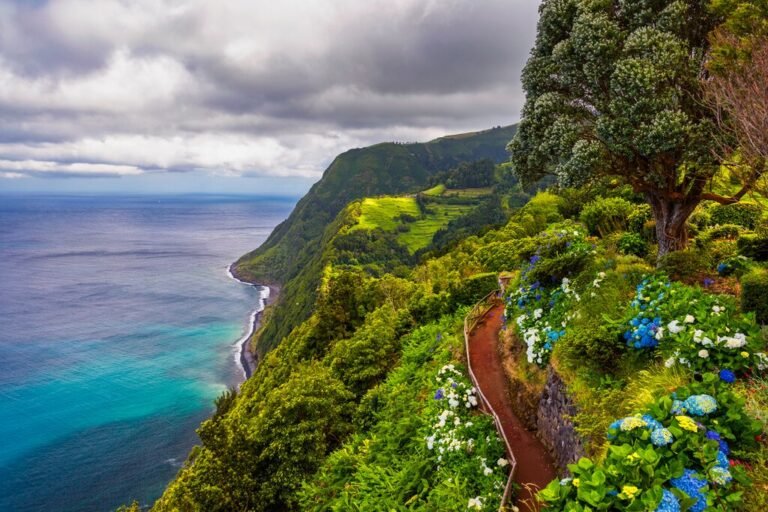Faial isn’t among the largest islands in Azores, so you should be able to visit the below attractions in 2 to 3 days. Of course you could go on a day trip to Faial as well and save the time, but that way you wouldn’t have enough time to do the longer hikes (worth doing) or additional activities.
Faial 3-Day Itinerary Overview
Day 1: Horta (Marina, Forte de Santa Cruz, Peter Cafe Sport, Church of the Holy Saviour, Torre do Relogio, Miradouro da Nossa Senhora da Conceicao, Monte da Guia Geosite, Praia Porto Pim, Porto Pim Whaling Factory, Porto Pim Aquarium, walking trail)
Day 2: West Faial (Morro de Castelo Branco, Capelo Handicraft Centre, Miradouro da Ribeira das Cabras, Praia da Faja, Capelinhos, Capelinhos Volcano Interpretation Centre, Farol da Ponta dos Capelinhos, Porto do Comprido)
Day 3: Central Faial (Caldeira, Salao Windmill, Botanical Garden of Faial)
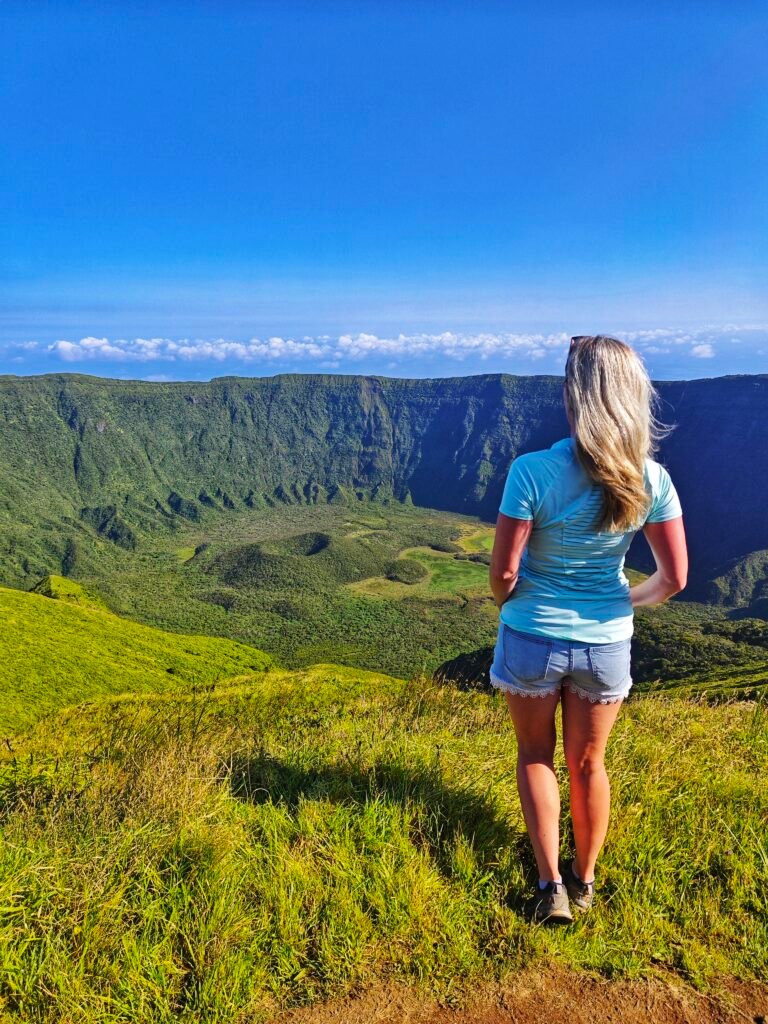
How to get to Faial?
There are several ways to get to Faial Island, depending on where you come from. I leave you all that information below.
Z letalom: Faial has an airport, close to the city of Horta. Between islands, flights to Faial are generally made on SATA propeller planes. The airport code is HOR, most airplanes fly in from Ponta Delgada (PDL).
S trajektom: There are ferries from almost all neighbouring islands to Faial. The ferry schedules can be found on the Atlanticoline – the only ferry service of the Azores. Ferries from Pico should be running pretty consistently throughout the day. From Pico it’s a quick 30-minute ride across the sea.
From Pico – a Day Trip option: If you are planning a day trip to Faial from Pico, that is certainly possible to complete. Since there are a bunch of ferries going back and forth each day, it should be no problem at all hopping on one at the Madalena port in the morning and then heading back at day’s end.
Just be sure to check the schedules as you do not want to end up missing the last ferry back! During a day trip (depending on what time you plan to start and end the day) you should be able to complete at least two attractions I mention in this Faial 3-day itinerary!
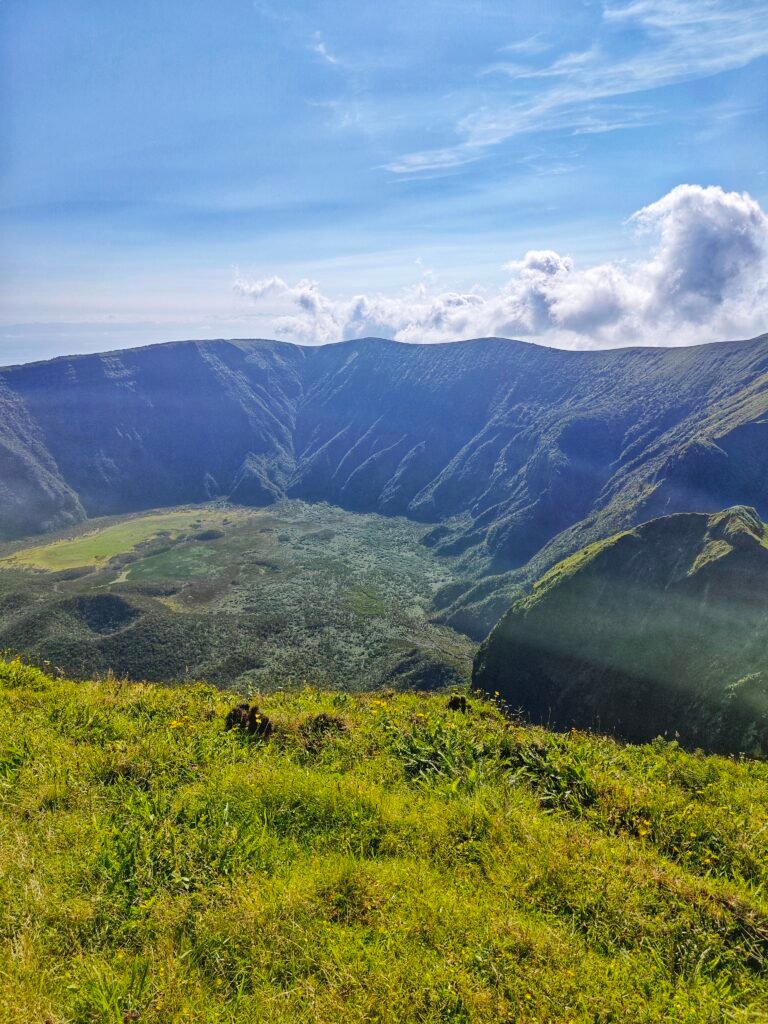
Renting a Car in the Azores
The best way to get around the Azorean islands is to rent a car. The process is easy – if you have a valid licence you simply walk into one of the stores and rent-a-car for the day (or two or more). Parking all around island is free of charge and parking lots are spacious and well marked. Driving around is very simple as well since the island itself doesn’t have a lot of traffic and the roads are nice.
I can recommend renting from Ilha Verde. They have multiple options and are easy to rent at.
>> Click here for rental car in Faial

You can also look for a scooter rental. There aren’t many options in Horta, but they can be rented for just 20€ per day.
Faial Tours for Those Not Renting a Car
If you are, in any reason, unable to rent a car, I recommend booking different tours to visit various locations around the island. Why? Because with just taking the public transport to go around you’ll see much less and need more time (and nerves). Public transportation is not as common in the Azores as one might like. Hence booking a tour is an obvious solution and you’ll get the most for your money.
I took some of the tours myself on my first visit to the Azores – found them to be very affordable and well-managed. Usually lunch is included as well, which comes handy.
Here are three highly recommended tours that will help you see a large amount of the sites I listed in this Faial itinerary:
- Faial Island – Van Tour – Full day
- Faial Island – Jeep or Van Tour – Half Day
- Full-Day Private Tour of Faial

Faial Itinerary Day 1 (Horta)
Horta town is a great base with lots of accommodation and restaurant options. Any other destination on the island is less than 40 minutes drive by car. Horta was founded in the 1400’s and is Faial’s largest urban centre and has a number of things to see and do.
Marina
The marina is a must-see, conveniently located in the city centre. This world-renowned marina has become a favoured stop on cross-Atlantic sea trips and is a linking point for international regattas. Many companies offer whale watching tours, fishing expeditions and sightseeing cruises from the marina.
A practice, which began centuries ago due to sailors’ superstitions, has become a tradition in the marina. Sailors paint their boats’ symbols or logos around the marina in order to ensure their boats and crews arrive safely at their destination. Be sure to wander through this free outdoor art gallery to see the artwork of crews from around the world. The art is everywhere along the marina sea walls and walks, including along the outside walls of the fort which guards the marina.
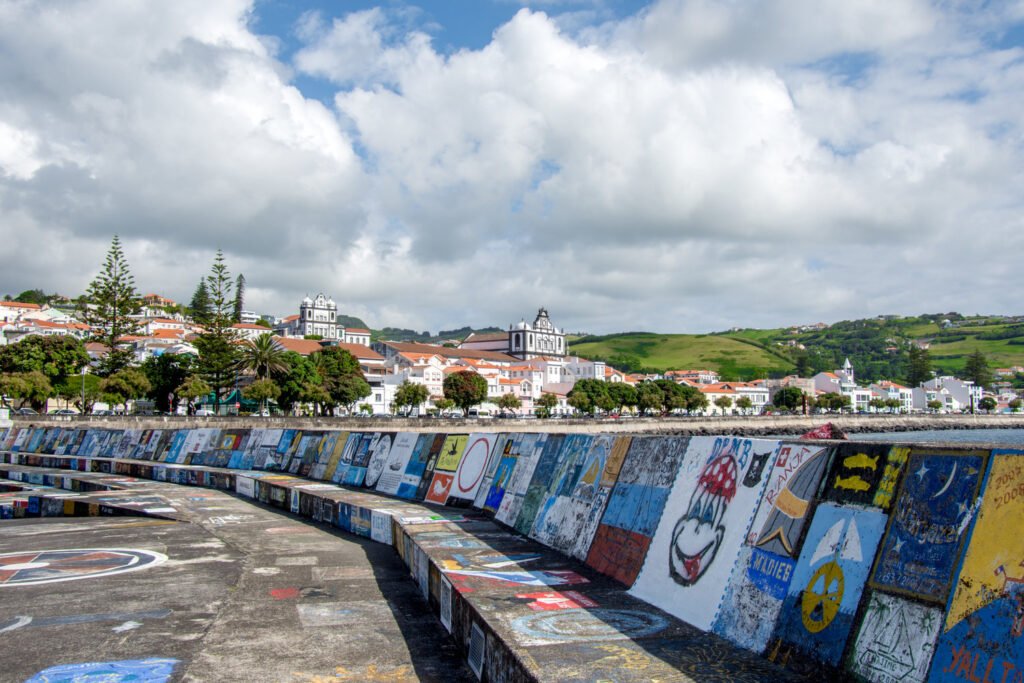
Forte de Santa Cruz
The fort was built between the 15th and 17th centuries and was the main fortification of the island. It became a national monument in 1947. Today, the fort is a luxury hotel called Pestana Pousadas de Portugal. The company operates hotels in some of Portugal’s most historic buildings.
Continue past the fort to what some consider yachting’s greatest watering hole.
For over 100 years, this has been a great place to enjoy your meal. It is worth a visit just for the decor alone. Beautiful walls of coloured yacht flags and ensigns allow you to travel the world from your chair with your favorite drink in hand.
Visit the Scrimshaw Museum to see the largest private collection of Scrimshaw artwork in the world. Scrimshaw art is engravings on and carvings from whale bone, cartilage or ivory, the byproducts of the whaling industry. The artists were the whalers. The museum pieces date back to the 19th century.
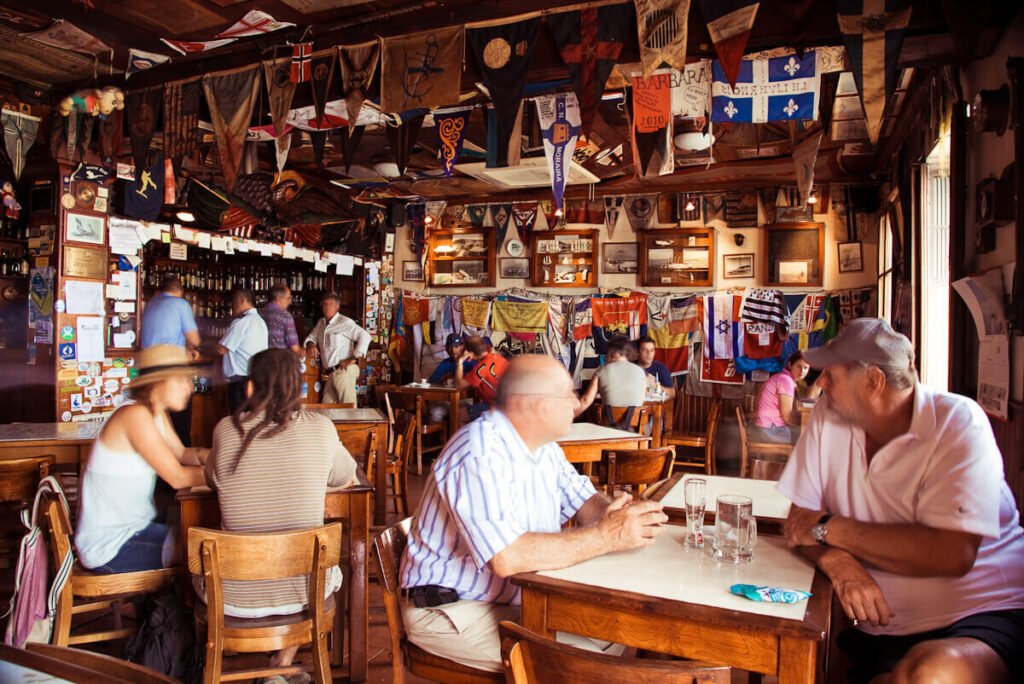
Church of the Holy Saviour
In the centre of Horta’s downtown, the imposing Igreja do Santissimo Salvador is one of the largest churches in the Azores. The former Jesuit College was abandoned around 1760 when the Jesuits were expelled from Portugal. Other buildings of the college have become the town hall and the Museum of Horta. The museum is noted for its collection of fig wood art, a traditional handicraft.
Torre do Relogio
This clock tower was used as a watchtower in the 1800’s. Climb the tower to get a bird’s eye view of Horta. Florencio Terra Garden, a beautiful park with a gazebo, is just across the street. It’s a perfect spot for a rest while enjoying the view over the city and neighbouring island Pico.

Miradouro da Nossa Senhora da Conceicao
This viewpoint of Horta lays on the main road. The 30-metre high cross and massive statue of the Virgin Mary stand out on the horizon. The view over Horta is breathtaking. On a clear day, look east to the islands of Pico, Sao Jorge and Graciosa. Much of eastern Faial can also be seen.
Close by, about 2.5 kilometres away, the Botanical Garden of Faial conserves and protects local plants.
Highlight of Horta – the geosite includes the volcano Monte da Guia, Porto Pim Beach and the volcanic cone Monte Queimado, plus all the sand dunes, slopes, cliffs, bays, inlets and marine caves around and within this area. This Azores Geosite is also two protected areas of the Faial Nature Park, protecting plant and animal species native to the Azores.
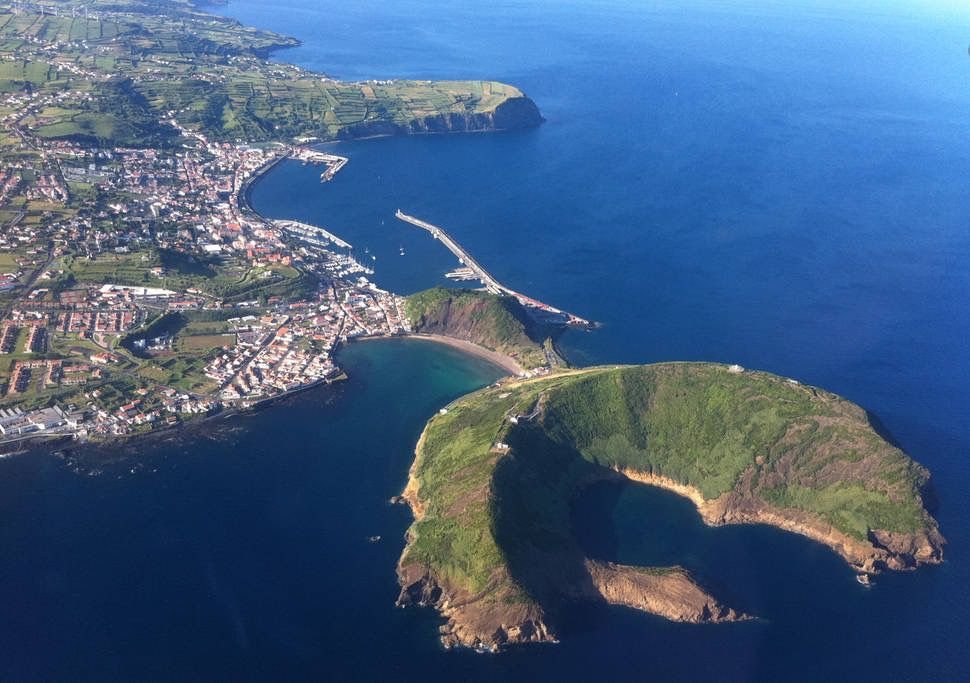
Porto Pim Beach
Beautiful, wide sandy beach is very popular with locals and tourists alike. There are washroom and shower facilities available (free of charge). Several restaurants and bars are on the streets around.
This museum shows the complete processing of a sperm whale. Its exhibits explain whale oil and grease extraction and the methods of handling the meat, bones and blood. The Whaling Factory museum contains most of the actual equipment used by the station during its business operations from 1941 to 1974. It is also the home of the Azores Sea Observatory, a non-profit organization dedicated to environmental education and activities in relation to ocean science.
Aquário do Porto Pim
The aquarium showcases fish species found in the waters around the Azores. You can learn about the biodiversity of the local ocean here. The aquarium promotes environmental awareness and assists with the recovery of sensitive fish and marine animals. Fish raised here have been sent to public aquariums around the world.
The building of the aquarium used to be a whale oil extraction plant which operated until 1942.

Walking Trail – Entre Montes (PRC8 FAI)
This circular route links all the places in the Monte da Guia geosite. It is an easy 3.4-kilometre walk, taking about 1.5 hours.
You can park in the large parking lot for Porto Pim Beach (free of charge). You start the walk on the paved path at the back of the Porto Pim Whaling Factory. Walk up to the top of Monte da Guia and Our Lady of Guia Chapel. Follow the trail markers to wind down to the south side of the bay, past the Porto Pim Aquarium, Dabney House and the Porto Pim Whaling Factory. Wander across the beach, along Rua da Rosa. Finally, head up over the top of Monte Queimado and back to the parking lot.
Piscina Lajinha and Poca da Rainha
These natural pools are about halfway towards the airport. They are natural hollows along the coastline filled with seawater and continuously refreshed by wave action. For a refreshing dip, take the steps down to the pools from the cliffs above. Be careful as the rocks are sharp and jagged. The rocks formed when rapidly flowing lava hit the cold ocean water and cooled very quickly. The cliff has beautiful caves and arches. This section of coastline is also a geosite of the Azores Geopark. The whole shoreline is visible from the beautiful viewpoint at Ponta Furada.
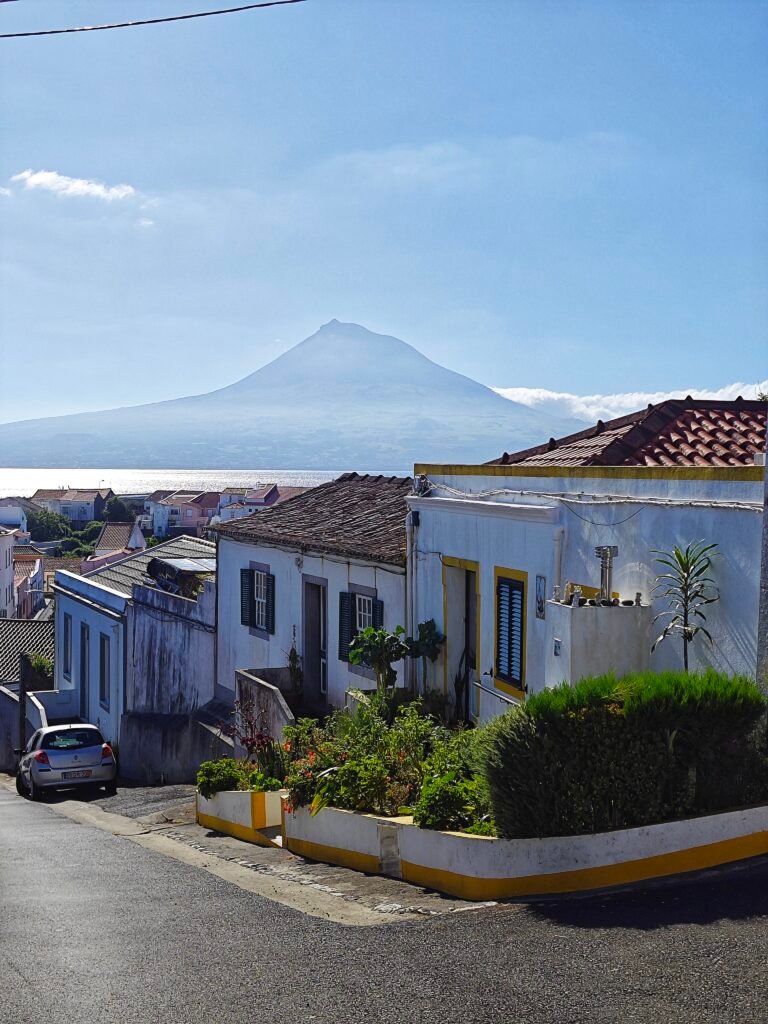
Faial Itinerary Day 2 (Western part)
We’re heading towards more interesting parts now – nature.
Morro de Castelo Branco
This huge, imposing, rock monolith at the ocean’s edge is visible from kilometres away. It forms a peninsula with plunging cliffs that extend into the water. It is a volcanic dome which was created from lava which was so thick that it didn’t flow away before cooling.
Climbing the rock peninsula is not permitted as the whole area is an important nesting area for several species of birds. It has been protected as both a Faial Nature Reserve and an Azore’s Geosite.
To reach the parking area, either drive, turning off the main road and following official signs, or hike to it on the Morro de Castelo Branco Trail. From the parking area (free of charge), walk the path to the amphitheatre and on to the base of the dome.
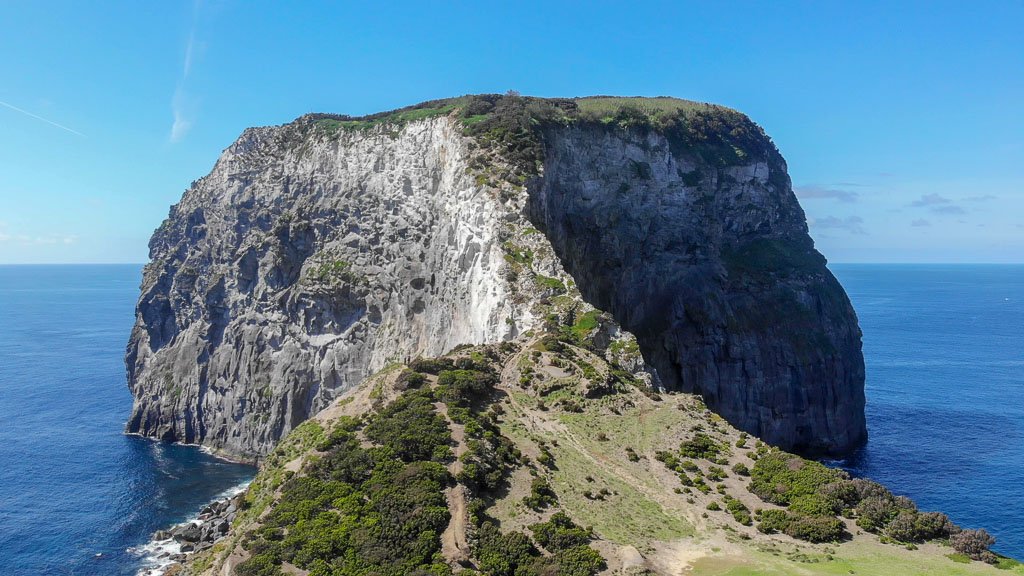
Capelo Handicraft Centre
The handicraft museum’s yard has a beautiful view of the ocean. Inside the small white stucco building, traditional island handicrafts are displayed and available for purchase. Find carvings in bone and whale’s tooth, fig tree pith (the centre core of the fig tree), straw embroidery, old lace and much more.
Miradouro da Ribeira das Cabras
This viewpoint provides an amazing view over the peninsula of Capelo, the youngest area of Faial (10,000 years old). The peninsula has about 20 volcanic cones of various sizes. On a clear day you can see Vulcao dos Capelinhos, Cabeco do Canto, Cabeco Verde and Cabeco do Fogo. Look down to Faja, whose land area was created by lava flows from the volcanoes of the peninsula.
Faja Beach and the nearby children’s playground are popular with summer vacationers. This rocky, black coastline showcases the sharp texture of rocks created when lava cools quickly in contact with water.
Faial’s youngest volcano was created during a 13-month eruption episode from September 1957 to October 1958. The eruption even created an additional island off the coast! Enough material was ejected from the volcano to join the new island to the mainland, increasing the area of Faial by 2.4 square kilometres. This area is one of the geosites of the Azores Geopark.
Wander the area, walking on the material jettisoned from the volcano, and admire the cliffs along the edges of the volcano. There are a number of things to see. Parking and entry to the volcanic area is free of charge, but Interpretation Centre is payable (but worth it!).
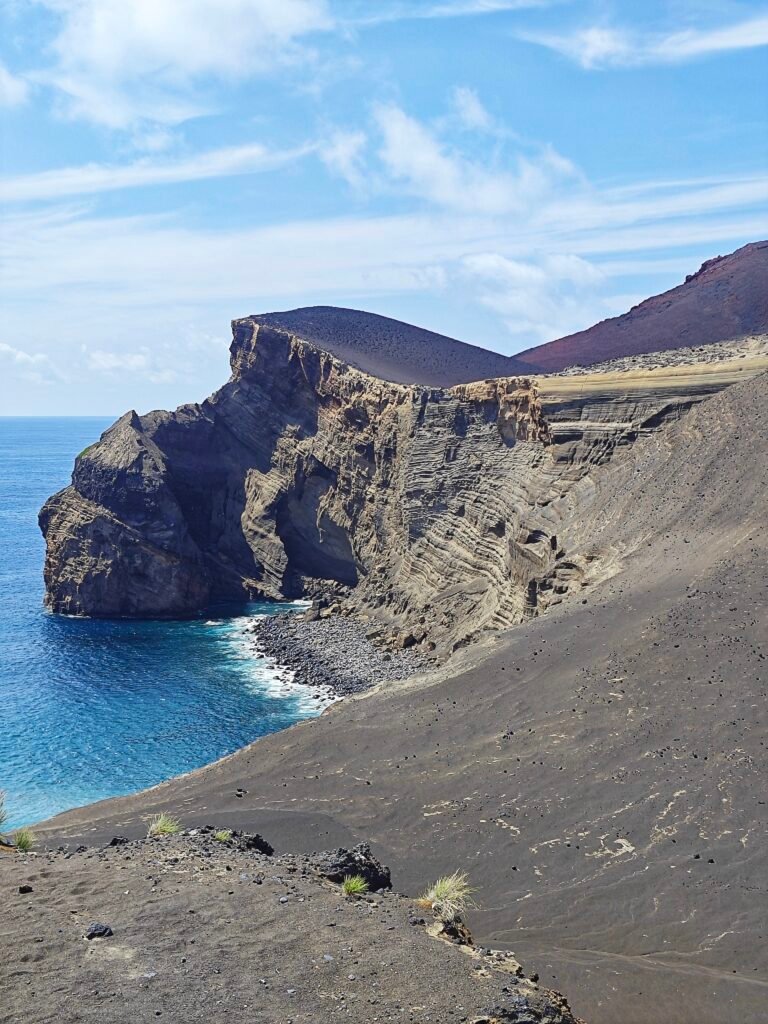
Capelinhos Volcano Interpretation Centre
The Interpretation Centre’s exhibit explains the Capelinhos Volcano eruption, the formation of the Azores islands, and the various kinds of volcanic activity in the world. The centre was built underground to minimize its impact on the landscape allowing visitors a better idea of how the area looked in the days shortly after the eruption in 1957.
Information on the history of Azorean lighthouses including the adjacent Farol da Ponta dos Capelinhos is also on display.
Entrance fee is 10€ for adults and less for children and seniors.
Farol da Ponta dos Capelinhos
Climb the lighthouse for a unique view of the area. The Capelinhos Point Lighthouse, built in the late 1800’s, was operating when the volcanic eruption began. As the eruption continued, workers cleared away the volcanic ash. Eventually the volume of ash became so large, it was necessary to abandon the area. Despite surviving the eruption intact, the lighthouse never operated again.
There’s usually a queue to enter the lighthouse, but it’s worth the wait if you’ve got time. You need a ticket to enter, which is the same ticket as the one in the Interpretation Centre.
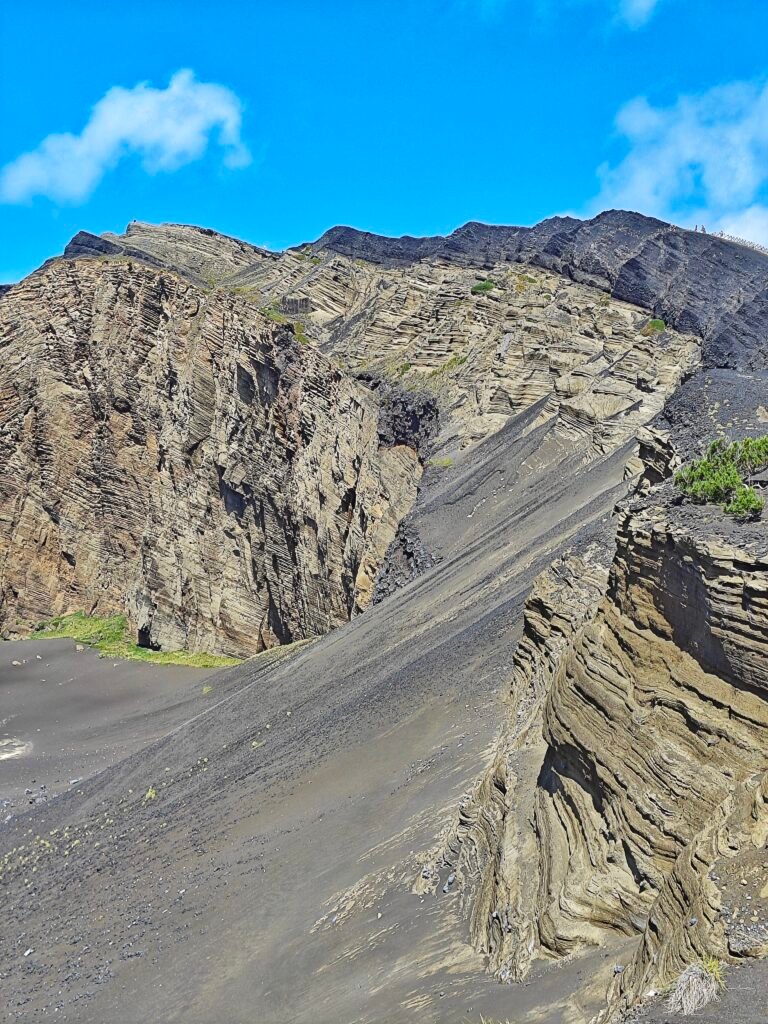
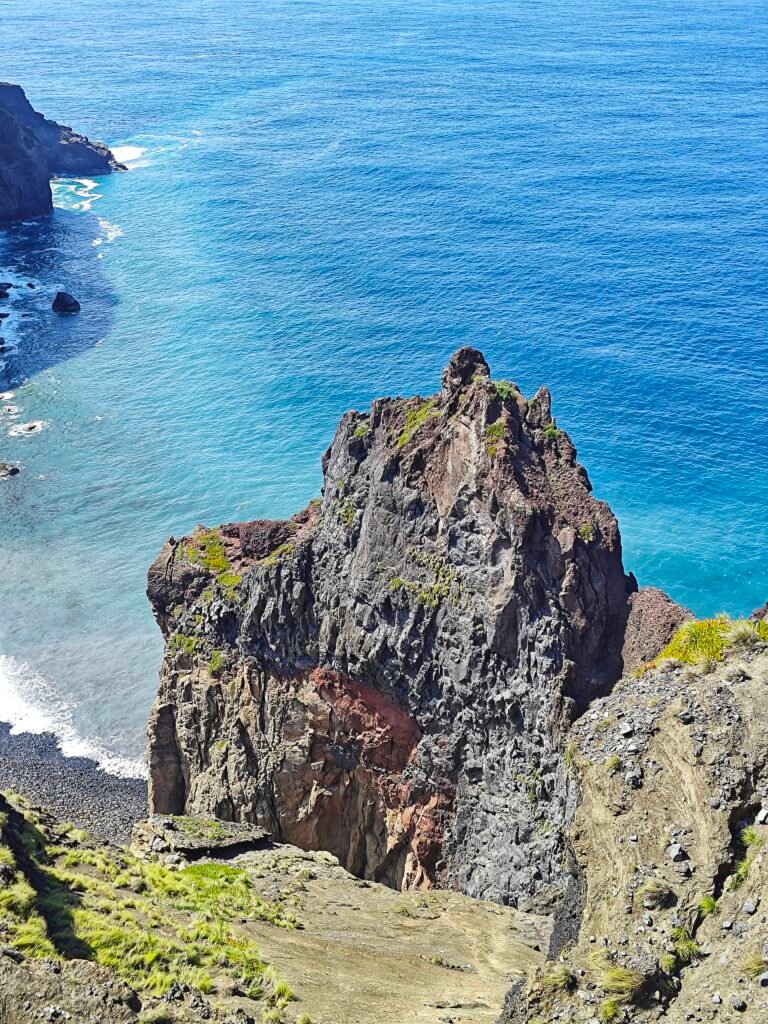
Cool off in the natural pool just 5 minutes walk from Capelinhos. You can also launch a kayak to take a look at the volcano from the ocean!
This point, Porto do Comprido, was the edge of Faial Island before the eruption. It is amazing to see how much additional land area was added to Faial as a result of the 1957 eruption.
Faial Itinerary Day 3 (Central part)
The highlight of Faial.
Caldeira
The most famous of all attractions on Faial is the MASSIVE Caldeira right in the middle of the island.
This caldeira is the crater of the volcano that created the island of Faial. It’s really a site to see – 400 meters deep and 2 kilometers in diameter, immense greenery in every direction. Within the crater itself you will see a smaller crater as well as some lakes too.
You have the opportunity to hike around the rim of the Caldeira. During a 2,5 – 3 hour hike you will walk for 8 kilometers and be able to see the crater from all different angles as you enjoy this incredible natural attraction.
If you don’t want to hike, no worries – you can just spend some time taking in the view for as long as you may like.
NOTE! You are not allowed to head down into the Caldeira. Also, the Caldeira is known to attract a fair share of low cloud coverage from time to time. If it’s cloudy you won’t see much, but as I’ve mentioned before, weather in the Azores changes rapidly. You can check the live situation on this webcam. https://www.spotazores.com/cam/caldeira/
There’s a parking lot on spot, free of charge.
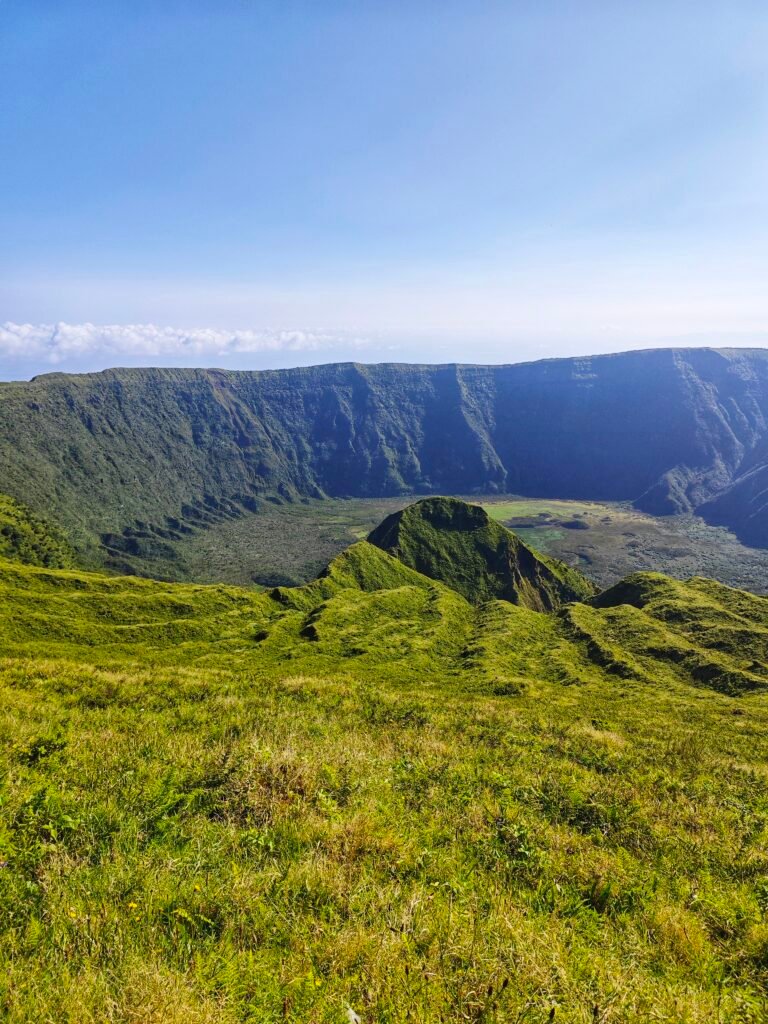
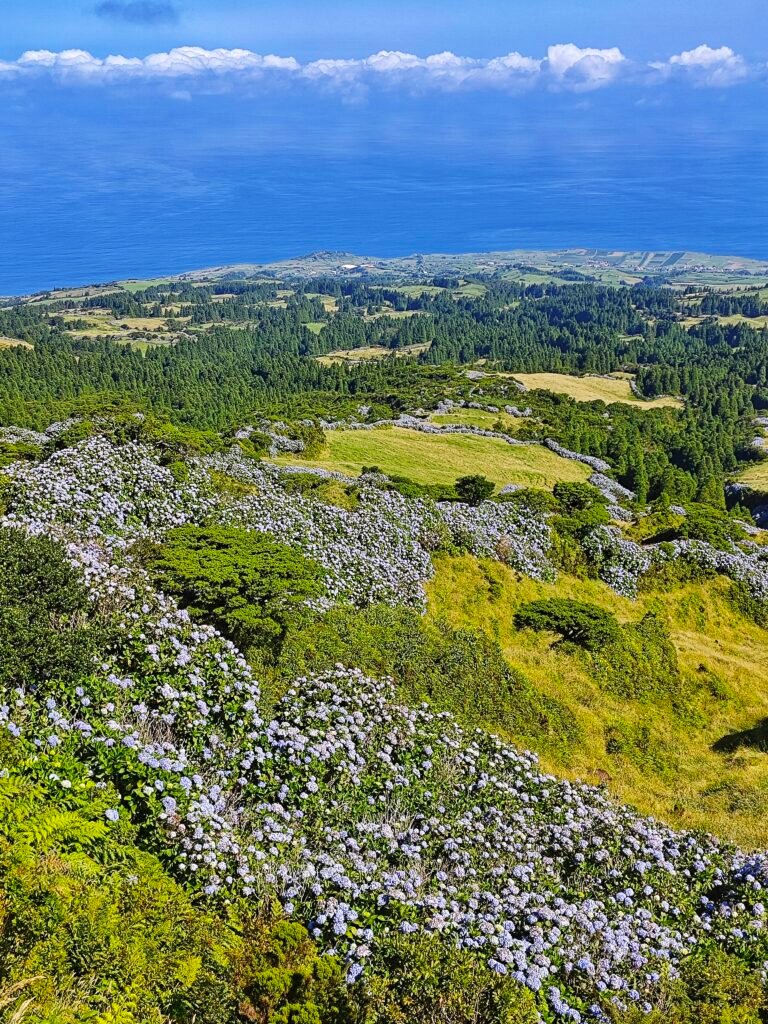
Salao Windmill
This red, wooden windmill operated between about 1929 and 1969 to grind the grain of the local farmers. There are many of these small structures on Faial in various states of repair. These windmills played an essential role in Faial’s important cereal industry in the late 19th and 20th centuries.
Botanical Garden of Faial
Learn about the importance of conservation and protection of the biodiversity of the Azores and the world. Opened in June 1986 with 1.4 acres, the botanical garden is now over 3.7 acres. The visitor centre has an auditorium, exhibition room and snack bar. The Botanical Garden also manages a natural rehabilitation area of almost 15 acres nearby.
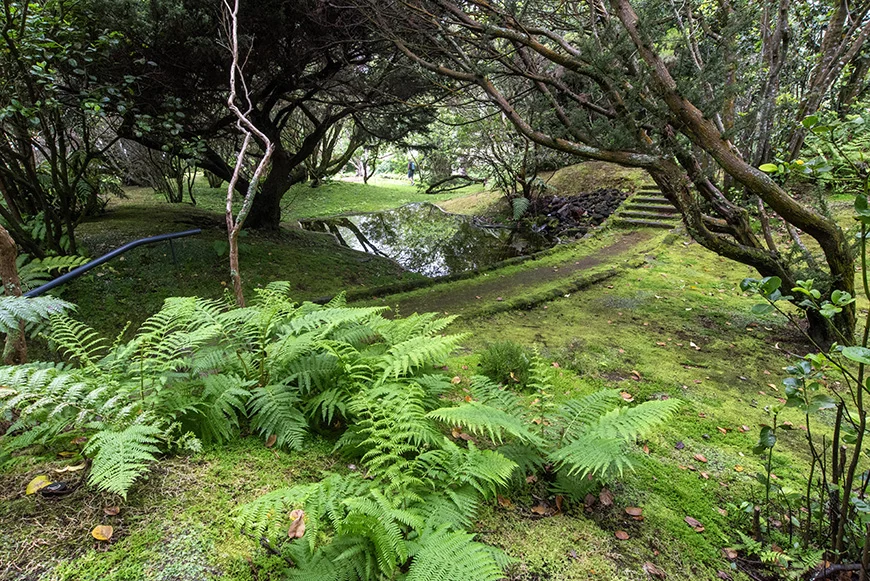
Če povzamemo vse...
You could definitely see the main attractions in Faial in 2 days only, but even stopping for a swim in one of the natural lava pools has its charm.
With all of that said we think you’re ready to visit Azores now 🙂 if you need further assistance with planning your trip don’t hesitate to contact us and get yourself personalised travel advice.
If you had a look at our itinerary plans for other Azorean islands you can see that you need quite some time to enjoy Azores fully. To save the time you can respond to wander call and join us in one of our group adventures!


